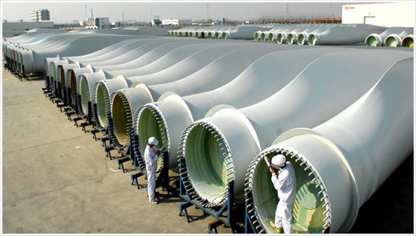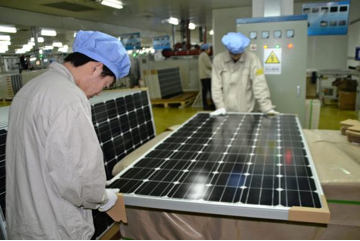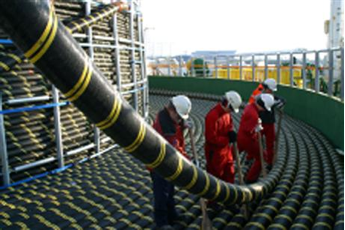
To address the dependence of our societies on fossil fuels will be an enormous undertaking, despite the recent re-appearance of often well-meaning analyses and reports emphasizing how comparatively easy and inexpensive it will be. The physical dimensions of this still mostly-future undertaking are often downplayed or misunderstood. Taken together, effective climate action will be made up of a series of interacting, at points interwoven, simultaneous, sometimes very large, building projects to achieve the outcomes we desire and require. As the outcome, the stabilization of the global climate, is a unitary outcome, these building projects can also be understood for some purposes as a single immense building project. As in all building or manufacturing projects, many costs will be incurred upfront for some immediate benefits in terms of employment and the sales of materials but many more of the benefits will be enjoyed years and decades down the road. Furthermore. those additional benefits associated with climate change will be very great and enjoyed still further down the road with an indeterminate but large monetary valuation.
Recent publications by the IMF and others have revived a recurring, often well-meaning discourse that the net costs over benefits of climate action will be minimal, overlooking or downplaying six important aspects of the challenge:
- There will be often a substantial time-lag between the incursion of costs and the experiencing of benefits; overlooking the time-lag does not create realistic expectations regarding spending timelines and annualized fiscal accounting.
- In many areas of climate action, earlier action and therefore greater investment sooner, will yield greater benefits both over time and in the immediate term.
- The financial costs and financial and real benefits will be experienced in a divided manner by differing and competing actors. Sometimes and dramatically, costs and benefits will be shifted between sectors & classes within the economy at large. Majorities of economic actors, mostly workers, the underemployed and the unemployed, are also currently experiencing continually reduced income, requiring radically increased spending (by others) to remedy, so overall minimized costs are little benefit to a majority of workers.
- The political and economic leaders who will direct the political economy of energy use and related activities will in many cases be a different group of people than is the case currently, indicating that a power struggle or major shift of some sort must occur
- In a modern monetary economy, real costs ultimately matter more than financial costs in macroeconomic cost accounting, especially in an endeavor that is focused on altering the real physical infrastructure and real atmosphere in very specific ways
- The primary real cost of failing to engage in effective climate action no matter its financial cost is incalculably large: the very high likelihood of the withering and disappearance of almost all of what we value, including a catastrophic disruption of the web of living things upon which our lives depend.
The “few costs” discourse, besides its misconstrued economics and cost accounting, seems to be attempting to lull people into thinking that we can continue with an only slightly altered status quo, investing, in one well-intended estimate, two hundred billion dollars per year over 20 years within the now 17 trillion dollar US economy.
An assessment of the physical changes involved in reducing carbon emissions and the speed at which they must occur to blunt or maybe avoid tipping points in climate and the worst of positive feedback loops (i.e., Arctic ice melt leading to lower albedo and greater heat absorption leading to more warming), indicates that much must change, quickly, in how the human-made environment would be composed. Currently 85% of global energy used, which in total is still growing, is sourced from fossil fuels, which cannot continue for long at all. Additionally, if we include the manufactured mechanical and industrial systems that actually use or convert energy to do physical work into the category “human-made environment” many of those too must change substantially regarding their energy inputs and outputs. For the United States, one of the world’s top emitters, these physical changes can be numbered in the hundreds of thousands of wind turbines, tens of millions of solar panels, one million electric buses, five million electric trucks, hundreds of thousands of miles of high-voltage cable, and tens of millions of highly efficient building retrofits and newly constructed buildings. These changes all require investment and the re-directing of financial means, both those of government as well as the private sector, towards those uses that yield a net-zero carbon future society.
Of course, this will not be simply a matter of making physical changes in the human-made environment by building things and manufacturing equipment. The building, retrofitting, and making new equipment will need to be proceeded by political shifts, leading or simultaneous with a cultural shift, as cognitive-motivational investments and commitment to the energy status quo must be reduced while cognitive-motivational, economic, and political investments in decisive climate action and energy transformation will need to become commonplace or majority opinion. Furthermore, the building of new infrastructure or the retrofitting of old and the purchase and use of new equipment must be accompanied by changes in energy-using behavior by people, through the development of new cultural patterns and norms for choice and use of energy. Climate action is a change in socio-technical systems, a combination of new social institutions, social relationships, and technological change.
There are additional advantages in viewing climate action as a building project with regard to emphasizing the role of planning. Under ordinary circumstances, planning has an integral role in the complex series of events that must take place to build a building or manufacture a durable & useful physical machine. The climate crisis can be viewed as a large-scale failure of social planning with regard to energy and the environment: it has been known for decades that fossil fuels were finite and also that their combustion would fundamentally alter the climate. Climate action cannot entirely undo that failure of planning but consists of instituting much better planning procedures into both the construction/manufacture of objects as well as with regard to the overall shape of coordinated climate action. In a carbon-constrained world, building and manufacture as it is now executed must be achieved with better planning. Overall, the role of planning and foresight based on high-likelihood outcomes predicted by the physical sciences must take a more central role in social institutions more generally.
While all of this may appear obvious upon reading it, current public discussions are focused on a number of areas that distract activists, political leaders, and pundits from the obvious. Anti-fossil fuel activists are often focused very much on pollution, both global warming pollution but, to a surprising degree, narrowly upon local toxic pollution, originating within the current energy and corporate regime, sometimes not seeing much beyond the local “bads” that are done in the name of energy and corporate profits. The struggle against the “bad” doesn’t seem necessarily lead to a grasp or realistic image of the “good” or “better” that we need to be building.
Others in the establishment climate movement have bought into the notion that simply assigning a price to carbon will lead, in the mysterious ways of the idealized “invisible hand”, to businesses building exactly what needs to be built. I have described elsewhere how this faith in markets is exaggerated and largely misplaced. A realization that specific physical objects need to be built or refashioned now or in a few years is an entirely different exercise from denouncing the evils of the fossil fuel industry or buying into largely mythical and ineffectual neoclassical/neoliberal economics as the savior of human civilization. Finally, the questionable cost-benefit analyses as outlined above that downplay major aspects and upfront costs of climate action, skim over the required physical, cognitive-motivational, and financial shifts and challenges.

Changes to the Built/Manufactured Environment
Below is a general though not complete list of what must be built rapidly for developed and rapidly developing societies to slow and halt their use of the atmosphere as a waste dump for warming gases:
- Electric grids extended or retrofitted (renewable energy supergrid) to conduct renewable energy from where it is strong or stronger to where electricity is used; install grid management systems that control flows of energy to meet demand and replace fossil generation.
- Radically increase the number of renewable energy generating facilities (wind solar, hydroelectric, geothermal, tidal) both at the site of consumption and also at varying distances from where energy will be used, connected by the increasingly demand- and supply-responsive electric grid connected to a supergrid.
- Connect electrical energy storage (in various forms and capacities) to the grid where it will balance and smooth power delivery from renewable energy generators
- Electrify transportation systems via public transit electrification, freight truck electrification, and rail electrification and via accessible battery recharge facilities for privately- owned & commercial battery electric vehicles.
- Build cities, towns and rural routes to safely enable low- or zero-energy transportation like biking and walking, separating pedestrians and bicyclists from powered vehicle traffic or calming traffic to allow comingling of all modes of transport and multiplying uses of street and public space.
- Site new buildings to encourage greater population density and therefore minimized energy use and/or emissions from transportation and to supply the inhabitants of those buildings with goods, services, and social contact opportunities they may desire with lower impacts.
- Build new buildings or retrofit existing buildings to require very little energy to maintain internal comfort using the Passivhaus standard or equivalent (e.g. Swiss Minergie-P) ; a target of “near-zero” will enable greater development density and therefore lighter overall footprint of building plus energy supply relative to a “net-zero” building by building requirement.
- Electrify mechanized agricultural processes, food processing and food transport
- Protection of defensible climate-endangered areas against expected sea-level rise/other expected climate consequences or resettlement of refugees from areas that are indefensible from climate related changes.
Each of these projects is a very large & urgent undertaking requiring materials, labor and financing as well as relatively precise execution to achieve the desired effects.
Types of Employment in Demand and Workforce Training
In order for the climate-action building project to proceed these are some of the types of labor for which there will much higher demand than currently:
- Energy Planners
- Carpenters
- Electricians
- Masons
- Forestry workers
- Solar Panel Installers
- Wind-turbine Installers
- Construction Machine Operators
- Factory assembly workers
- Building Energy Analysts/Modelers
- Public transit workers
- Bicycle traffic law enforcement officers
- Building project public liaison workers
- Power Engineers
- Mechanical Engineers
- Structural Engineers
- Materials Scientists
- Architects
- Urban Planners
- Project Managers
- Project finance specialists
- Environmental certification specialists
- Energy regulators
- Forest and agricultural carbon balance regulators
- Agronomists/Agricultural scientists
- Workforce training specialists
Traditional training in some of the above professions or trades may not be adequate in amount or in focus to be able to execute some of the tasks required for effective climate action. Re-training to adequately execute the tasks associated with cutting emissions or energy use will be a large component of the first few years of sustained climate action.
Unlike the assumption in some policy circles that job retraining is a sufficient jobs policy, publicizing the value of these professions and retraining workers in them is not adequate to execute the task and employ people in these professions. Demand for these types of labor via financing of the projects and then their utilization by either government or the private sector needs to occur in order for employment to occur, financial gains to be achieved by those who do the work, and for the actual effect upon societal emissions to also occur. This may seem obvious but policy discussions sometimes tend to float over reality.

Climate Risks Associated with the Building Project Itself
It will be important to minimize the atmospheric impacts of taking these actions, even as we will need to execute many of them quite rapidly. Currently building and manufacturing are activities that are dependent upon the use of fossil fuels in the manufacture of materials, in the transport of materials, and in the assembly of those materials. While for many applications there are now some substitutes, steel and concrete remain common and sometimes required inputs for many building and manufacturing processes; each is a fairly emissions-intensive material. Until such time as most manufacturing and building processes are powered by clean energy, the process of taking climate action can be likened to transforming fossil energy and associated emissions into durable products that in operation substitute for services produced currently by burning fossil fuels. The first decade or so of effective climate action might then be interpreted as kind of a process of physics-based “alchemy” whereby fossil energy is strategically transformed into generators and machines that do not require more fossil energy to operate and produce useful work. Later on in the process, we can dispense with this “alchemy” as there will be sufficient clean energy to produce new machines without any embedded carbon emissions.
For some, who tend to think in terms of a radical separation between the “pure and good” and the “profane and bad”, the transitional period will be hard to process in mental terms. Transforming fossil fuels (the bad) plus other materials into durable products like a solar panel or wind turbine that don’t emit carbon in operations will be a necessary tradeoff for many years to come. A refusal by policymakers or political movements to “allow” or confront this ambiguity may slow down the political process of accepting that climate action will involve the strategic use of some fossil fuels harnessed to the goal of creating a fossil-free society.
Beyond the mental and specifically ethical-political difficulties of understanding this transitional use of fossil energy, are real physical dangers associated with the emissions from the climate-action building project itself via the use of these fuels. To limit these possible damages, materials will need to be selected that have lower emissions or in some instances represent zero negative net emissions (sustainably harvested woods and plant-based products or recycled materials). With or without a global, national or local across-the-board carbon price, carbon accounting must occur with financial consequences either in the form of reasonable penalties for excess emissions above expectations or incentives for reducing emissions below expected via clever design and selection of materials. An across the board carbon price will penalize the expectable emissions that will occur in projects that require steel and concrete made with fossil fuel inputs for the foreseeable future and may therefore unnecessarily burden and slow progress towards reducing overall societal emissions during their operation.
Other efforts will involve conservation efforts that will “make room for” the emissions related to critical activities associated with the climate transition. Turning to lower impact activities like biking, carpooling, and public transit use for routine trips, can reduce overall emissions. A possible guide in such work is creating a matrix or priority list of those efforts, for instance energy efficiency work, which will have a greater knock-on effect of reducing emissions if completed earlier than the work of building, for instance, renewable energy generators to accommodate the energy demands of current inefficient structures and machines. Efforts as well to “purify” the climate action building project of all carbon emissions may need to be resisted. If efforts to create a virtuous circuit of zero emissions energy and materials are premature, this may limit the application of zero emissions generators in areas where they will cut overall emissions more by replacing fossil generation or fossil fuel combustion more generally.

A Targeted Effort Keyed to Performance
Policy as regards public investment and procurement as well as regulation of the private sector must be targeted towards achieving geophysical goals via a fair and equitable social process. Previous and current booms in construction have occurred, most of the time without clear direction and goal-setting by regulators. The massive building project that will be climate action will have some characteristics of previous and current construction booms in different parts of the world as some inputs into production will at times be in short supply. However conditions must be placed on financing or incentives which focus activities upon those projects that will yield net benefits for the public good, both geophysical and social, while serving the acknowledged and reasonable private aims of users and financial beneficiaries as well.
With government funded and owned projects the targeting will take place via the specification by government regulators of particular characteristics for projects to be executed by government contractors. Such project proposals however should also be subject to review by an overall climate action project planning group which will review projects based on atmospheric impacts as well as other favorable or unfavorable qualities related to use, appearance, economics etc. A formalized project commissioning process should include best practices in putting the piece of infrastructure or equipment into operation. Government projects, of which there will be many, should also be subject to utilization and effectiveness reviews, perhaps at the 1-year, 2-year and 5-year marks to guide future government projects and refine best practices.
For those climate actions that occur within the private sector, the requirement for projects to meet certification standards will be attached to the granting of financial incentives upon which the project should depend for its financial viability. For instance, one massive component of activity within the private sector will be the retrofitting of existing buildings and the building of new buildings to a rigorous standard such as the Passivhaus standard, which has the advantage of offering a relatively simple set of criteria, while targeting a very low energy use standard for buildings based on floor area. The Passivhaus standard requires that buildings meet a measurable air-tightness standard, and modeling of energy use that is below a certain amount for space conditioning and then one modeled for overall energy use, all per unit floor area. Incentives for building the building or, for that matter an incentive like zero-interest financing, should be contingent on certified, measurable results, perhaps delayed for a year or two to verify performance. Other incentives might be tied to, for instance, the use of low-emissions materials or processes in the building of the project.
Thus a combination of internal or civilian-review board oversight of government itself as well as performance-oriented government regulation of the private sector should be designed to focus and target building efforts on those projects that will actually yield cuts to overall greenhouse gas emissions reductions or another target, such as effective protection of an endangered but defensible area from the effects of climate change. Rather than, as has been the case in building booms in the past, structures being built to serve narrow financial and speculative motivations of the project owners, in the case of climate action, a combination of impulses and interest groups will be served by focusing development on goals that serve both private and public aims simultaneously.

Reverse-Engineering Policy For Concrete Results
Climate policy proposals and instituted policy itself have tended to be derived from social science theory, in particular variants of neoclassical economics. The notion of a carbon price as the central fulcrum of climate policy is supported mostly by the faulty assumption that the more-or-less invisible hand of the market is what creates manufactured and built reality largely by itself. In for instance, real estate, the market does shape the distribution and types of housing in the context of a natural and government-created landscape and structure of economic demand. Markets however, are almost always led, controlled by and preferentially serve those with high or top incomes, increasingly so in recent times, and cannot in a systematic way restructure themselves. Furthermore, without regulation and continual government investments, the dynamic of markets increases the tendency of the income distribution to become skewed to the already-wealthy, undermining overall economic welfare.
In carbon pricing proposals, be they cap and trade or carbon tax/fees, government and the polity “hide” behind the price or permit auctions, which are supposed to represent the public’s valuation of the atmosphere and the future of humanity that depends upon the atmosphere’s composition. A carbon-pricing centered climate policy also rests on “bad faith” political “forgetting” of what is known already about climate solutions, hoping that the “market” eventually will come to decide in its own time, what is already understood by most intelligent human beings with a passing knowledge of physics and technology (i.e. electrify, save energy, switch to renewable energy). Public agencies that do not generally pay taxes are also the only economic actors suited to building and owning some of the critical social and physical infrastructure required for a net zero emissions society.
While price effects are not to be ignored and raising the price of fossil energy, once alternatives are in place, is a good idea, it is far more important to build alternatives to using fossil fuels right away by direct government investment or via the creation of targeted policy to produce the results that we know that we require. Sovereign currency issuing governments, like the US federal government, are particularly suited to making direct investments as they do not need to balance taxes received with expenditures. Such investment by sovereign currency issuing governments will fill a more general overall economic demand gap that currently exists in most developed societies and will more rapidly deploy and employ people and material resources via financial means. A reliance on carbon taxation or pricing alone could if not counterbalanced, lead to stifling of economic activity overall in economies that are demand constrained, particularly those activities like manufacturing and construction that will in the interim depend on fossil fuel inputs.
Thus it makes sense to reverse-engineer policies, some combination of government planning, spending and regulation, from their desired results that will yield the mix of physical products and processes needed to cut emissions rapidly. It is not surprising this approach has been only hit upon often but inconsistently by policymakers throughout the world as it violates some of the sacred cows of traditional economics dating back to Adam Smith that suggest that “the producers” are to be contained by economic policy rather than encouraged. In the actual history of economies rather than the arid abstractions of conventional economic theory, it has only been through anti-orthodox “industrial policies,” i.e. strategic support of “producers”, by which nations have created industrial bases from which they have then gained some advantages over free trade and pursued a path towards development. Reverse-engineering policies to produce certain physical infrastructure and outcomes is a form of an industrial policy, focused on geophysical goals.
Specific policy initiatives to enable renewable energy development include stabilized prices for renewable energy generators enabling a return on investment and reasonable profit for investors. Government can also invest in transmission to high quality renewable energy areas to enable the supported, regulated market for wind turbines or solar farms to overcome a significant political, economic, and regulatory hurdle. Similarly in building energy efficiency, policies that direct private capital and building owners’ own capital to deep energy retrofits to Passivhaus-level performance or to new construction with similar performance are all portions of how specific policy goals can be achieved more rapidly than via the blunt instrument of carbon pricing. Additionally, housing affordability and supply is most likely to be addressed by government regulation and spending on housing, rather than the simple response of private developers to a single price.
Removal of subsidies from fossil fuel exploration, development and refining can both discourage investment in fossil fuels and encourage the flow of investment into renewable energy and energy efficient buildings and products, providing that government has laid down specific ground-rules about goal setting for emissions during operation. As I have argued elsewhere, focusing on an intermediate “low-carbon” society is unacceptable when dealing with long-lived infrastructure that can with different or moderate additional investment become piece of a zero-net-carbon society. Investment in natural gas or other reduced carbon fossil fuel options represents in most contexts a lost opportunity to build or manufacture objects with zero or near-zero emissions potential.
The mobilization of governments and the domestic private sector to address climate change should occur independently of the determination of carbon tariffs and carbon pricing which should be used as adjuncts to organizing the building of a net-zero emissions energy and transport infrastructure. Carbon taxes should be used to drive consumers and businesses towards zero- or lower-emitting activities and products not as an initial starting point for the transition to a net-zero emitting economy. Similarly carbon tariffs should help foment international competition in reducing emissions in production, stirring those regimes that are not eager to cut emissions to reduce their emissions or lose competitiveness.











